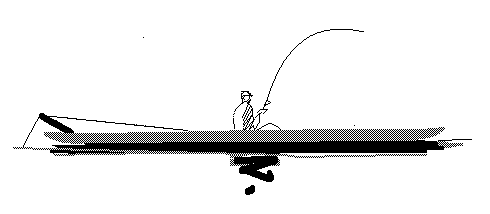Welcome to River Magic
Stillwater Slim on the Line... March 10, 2009
|
 Deeper Inside DFO Last week we saw that DFO Scotia-Fundy uses a neat and tidy approach to managing Atlantic salmon fisheries in our zone. Not only is it neat and tidy, it seems easy, all based upon two numbers, the theoretical number of adults required as spawners in a given river system, and the actual population of adult salmon in the system. But looking deeper inside this neat package, we find a can of worms! One weak link in this strategy is that the actual population number is elusive, due mainly to the nature of DFO’s assessment methods and the variability of our weather. The number, with a variance of 100%, is determined from data gathered from juvenile fish assessments, smolt wheel counts, scientific kelt fishery results, an index river count, angler license stub reports and adult mark-and-recapture assessments. Because the LaHave River in Lunenburg County has an operational fish counter at the Morgan Falls fishway, DFO can obtain an accurate population assessment for the LaHave (but only the portion of one branch above Morgan Falls). Even though the timing of salmon runs (LaHave runs are at least two weeks earlier than St. Mary’s) indicates the irrelevance of the LaHave number to the St. Mary’s River, it is nonetheless weighted heavily in estimating St. Mary’s population abundance. The adult assessment is done in the early fall of each year on the west branch of the St. Mary’s (three pools), with the recapture seining being weather dependent. As autumn progresses it often brings frequent and heavy rains to the St. Mary’s that cancel the recapture phase. So, we see a great deal of effort being expended to determine a number by scientific methods and crucial to DFO fisheries management, yet is extremely error prone. Wouldn’t we be far better to focus efforts on increasing the St Mary’s production capacity and increasing the number of salmon? When you really think about it, DFO Scotia-Fundy’s strategy is redundant anyhow, because our fisheries are self-regulating. Fishing effort and resulting catches are directly proportional to population abundance. When fish are few, so are fishers. Recognizing the self-regulating nature of Aboriginal and sport salmon fisheries, DFO’s Gulf Region has the Margaree River’s salmon season from June through October, and, should a decline in number occur in future, hatchery stocking can supplement their salmon population. DFO is also responsible for protection of salmon in inland waters such as the St. Mary’s River. In recent years DFO has shared this responsibility with Nova Scotia’s Dept. of Natural Resources (DNR) so that DFO’s dwindling resources could focus on the lobster and crab fisheries. The presence of anglers is a poaching deterrent, but DFO closed the west branch of the St. Mary’s River to salmon fishing in 2008. Protection of salmon becomes most critical during periods of low water, when salmon are most vulnerable, and high water temperatures make salmon extremely hard to catch legally, but not illegally. The reasons why Guysborough County’s share of salmon sport fishing expenditures in Nova Scotia is only 1% compared to Inverness County’s 66% are becoming clearer. The can is full of worms. These are just a few. Please stay on the line ... |